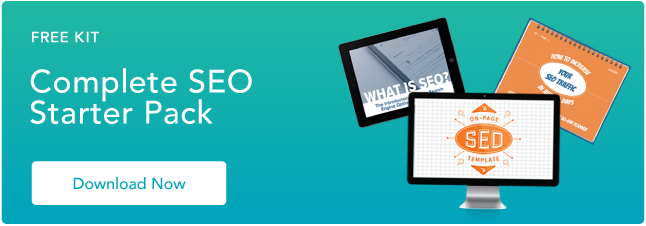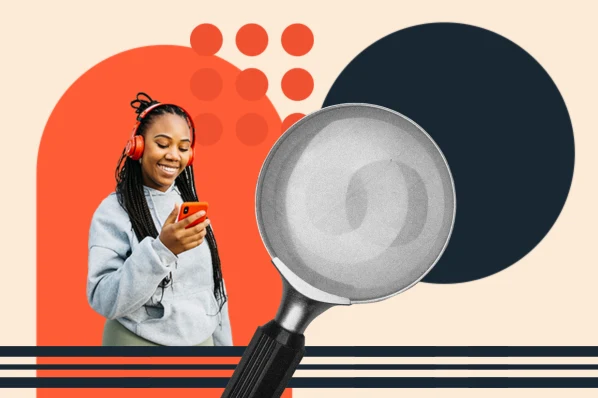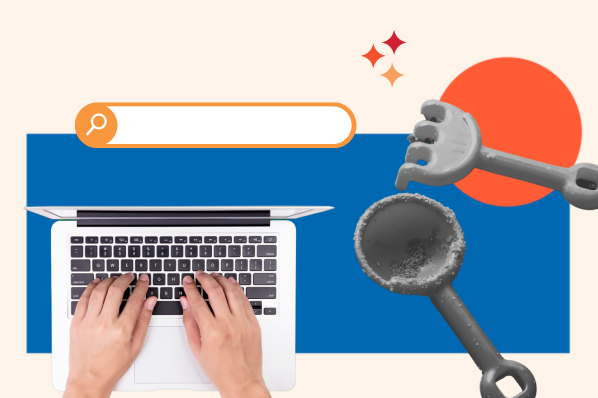Do you want to optimize your website but have trouble communicating with the technical folks running it? Then, you need an SEO glossary.

Jargon alone shouldn't stop you from making your site the powerful marketing tool it can be.
This is a list of the most essential search engine optimization (SEO) terms to help marketers communicate with developers and understand how to optimize their websites.
# | A | B | C | D | E | F | G | H | I | J | K | L | M | N | O | P | Q | R | S | T | U | W | X |
40 SEO Terms You Must Know!
Numbers
2xx status codes – Code sent by the server to say that the request was successful.
301 Redirect – The process of permanently redirecting a webpage from one URL to another.
302 Redirect - The process of temporarily redirecting a webpage from one URL to another.
4xx status codes - Code sent by the server to say that the request was unsuccessful and the information was not found.
5xx status codes - Code sent by the server to say that there was a problem with the server.
A
Accelerated Mobile Pages (AMP) - An open source project by Google to help publishers create webpages and content that are optimize for all devices.
ALT Text/Alt Attribute - A description of an image in your site's HTML. Unlike humans, search engines read only the ALT text of images, not the images themselves. Add ALT text to images whenever possible.
Anchor Text - The actual text of a link to a web page. On most websites, this text is usually dark blue and underlined, or purple if you’ve visited the link in the past. Anchor text helps search engines understand what the destination page is about, it describes what you will see if you click through.
Authority - How reliable a website is based on search engine's algorithm.
B
Backlink - A link pointing to an external webpage.
Black Hat - Practices that go against Google's webmaster guidelines.
Blog - A webpage that includes blog posts related to specific topics and/or industry.
Bookmark - A link to a website saved for later reference in your web browser or computer.
Bot - A software application that is programmed to complete specific tasks.
Bounce Rate - The amount of users who leave a webpage after only viewing one page.
Branded Keyword - A search query (keyword) that refers to a specific brand. E.g.: "Nike shoes"
Breadcrumb - A web link that lets you know where you are on a website and how far you are from the homepage.
Broken Link - A link that leads to a 404 error page. This can happen if a webpage is removed without a redirect. (See 4xx status codes)
Browser - Software that allows you to access information and data on the internet. The most common browsers include Google Chrome, Safari, and FireFox.
C
Cache - A storage location that collects temporary data to help websites, apps, and browsers load faster.
Canonical URL - The canonical URL is the best address on which a user can find a piece of information. Sometimes you might have a situation where the same page content can be accessed at more than one address. Specifying the canonical URL helps search engines understand which address for a piece of content is the best one.
ccTLD - Stands for country-code top-level domain and is used to define the domain for a specific country or region. E.g. www.mysite.co.uk
Cloaking - A black hat practice used to display different information on a webpage than what was expected.
Conversion Form - A form through which you collect information about your site visitor. Conversion forms convert traffic into leads. Collecting contact information helps you follow up with these leads.
Crawler - A program used by search engines to gather information on websites and accurately index them.
CSS (Cascading Style Sheets) - The part of your code that defines how different elements of your site look (examples: headers, links).
D
Deep Link - This can refer to two things: A link pointing to content on a mobile application or a link pointing a webpage other than a homepage.
De-Index - When a search engine removes a website or webpage from search results.
Disavow - When you tell Google to ignore links because they're low-quality, spam, or artificial.
Do-follow - A hyperlink that instructs search engines to follow the link instead of the "nofollow" attribute. (See nofollow)
Domain - The main web address of your site (example: www.yoursite.com).
E
External link - A hyperlink that points to a webpage on another domain. This is also known as a backlink. (See backlink).
F
Featured Snippet - Highlighted excerpts that appear at the top of some Google search results, known as position 0.
The Fold - The "fold" is the point on your website where the page gets cut off by the bottom of a user’s monitor or browser window. Anything below the fold can be scrolled to but isn’t seen right away. Search engines place some priority on content above the fold since it will be seen right away by new visitors.
G
Google My Business - A local business directory from Google.
Google Search Console - A free Google tool that allows you to monitor how a website is performing.
Guest Blogging - The practice of publishing a blog post on a website owned by someone else.
H
Header tag - Code used to designate headings and subheadings from paragraphs.
Headings - Section headers on your website that are placed inside of a header tag, such as an H1 or H2. This text is often presented in a larger and stronger font than other text on the page.
HTML - The code part of your website that search engines read. Keep your HTML as clean as possible so that search engines read your site easily and often. Put as much layout-related code as possible in your CSS instead of your HTML.
I
Image Compression - The practice of reduce an image's file size to speed up a web page.
Indexing - A process used by search engines to analyze the content of website and catalog files.
Inbound Link - A link from another website to yours.
Internal Link - A link from one page to another on the same website, such as from your homepage to your products page.
Indexed Pages - The pages of your website that are stored by search engines.
J
Javascript - A scripting language that allows website administrators to apply various effects or changes to the content of their website as users browse it.
K
Keyword - A word that a user enters in search. Each web page should be optimized with the goal of drawing in visitors who have searched specific keywords.
Keyword Difficulty - Refers to how competitive a keyword is and how difficult it will be to rank for it.
Keyword Research - The process of searching for keywords to target in your content based on volume, keyword difficulty, and other factors.
Keyword Stuffing - The overuse of keywords in your content in an attempt to rank higher.
L
Lazy Loading - A method used to improve page speed by deferring the loading of an object until it's needed. An example of this is the infinite scroll on websites.
Link Building - The activity and process of getting more inbound links to your website for improved search engine rankings.
Link Juice - The value or authority a website gains when receiving a backlink from a high-authority website. (See backlink.)
Link Schemes - What Google defines as spammy tactics used to trick Google's PageRank and increase search rankings by buying or selling links, excessive cross-linking, or other manipulative tactics.
Long Tail Keyword - Longer, more specific queries that include more than three words.
M
Metadata - Data that tells search engines what your website is about.
Meta Description - A brief description of fewer than 160 characters of the contents of a page and why someone would want to visit it. This is displayed on search engine results pages below the page title as a sample of the content on the page.
Meta Keywords - Previously used by search engines in the 90s and early 00s to help determine what a web page was about, the meta keywords tag is no longer used by any major search engines.
Minification - The practice of removing unnecessary characters in the source code to help a page load faster without affecting functionality.
Mobile-first Indexing - This refers to Google primarily using the mobile version of a webpage for indexing and ranking. In the past, desktop was the go-to.
N
Nofollow - When a link from one site does not pass SEO credit to another.
O
Organic traffic - Refers to visitors who discover your website on the SERPs instead of a paid ad.
P
Page Speed - Refers to how quickly a webpage loads. Influencing factors include file sizes, the source code, and the web server.
Page Title - The name you give your web page, which is seen at the top your browser window. Page titles should contain keywords related to your business. Words at the beginning of your page title are more highly weighted than words at the end.
PageRank - A number from 0-10, assigned by Google, indicating how good your overall SEO is. It is technically known as 'Toolbar PageRank.'
Pagination - When a series of content is broken up into a multi-page list. Think of category pages on e-commerce sites.
Panda - Was previously a separate Google algorithm to track down black hat tactics but now is part of Google's core algorithm.
People Also Ask - A feature that can show up on the SERP to show related questions and answers to a query.
PPC (Pay-Per-Click) - Advertising method in which an advertiser puts an ad in an online advertising venue and pays that venue each time a visitor clicks on his/her ad. Google AdWords is the classic example of this.
Q
Query - The words or phrases a user enters into a search engine.
R
Rank Brain - Machine learning component of Google's algorithm which works to understand queries and deliver the best results.
Ranking Factor - The factors that influence a website's ranking on search engines.
Redirection - When a URL is moved from one location to another. (See 301 and 302 Redirect).
Referrer String - A piece of information sent by a user’s browser when they navigate from page to page on the web. It includes information on where they came from previously, which helps webmasters understand how users are finding their website.
Rel=canonical - An HTML tag that tells search engines which version of a webpage is original and which is duplicate when there are multiple pages with similar content. (See canonical)
Responsive design - A design practice that allows a website to adapt to any device it's viewed on, making it a better user experience.
Robots.txt - A text file that tells search engine crawlers which areas of your website are accessible and which ones they should ignore.
RSS Feed - RSS stands for 'really simple syndication.' It is a subscription-based way to get updates on new content from a web source. Set up an RSS feed for your website or blog to help your followers stay updated when you release new content.
S
Search Intent - Refers to the reason why a user conducts a search.
Search Volume - The number of times a keyword is searched in a given period, usually a month.
Seasonal Trends - Natural increase and decrease of keywords during specific times of the year. E.g.: The keyword "Halloween costume" sees an increase in the fall months and a dip in the spring and summer.
Seed Keyword - Short-tail keyword, also known as a root keyword, which is the primary keyword you want to rank for and considered the umbrella term.
SEO - Stands for search engine optimization and refers to the tactics used to optimize your website page to reach and maintain a high ranking on search engines for particular keywords.
SERP (Search Engine Ranking Page) - The page that you are sent to after you run a query in a search engine. It typically has 10 results on it, but this may vary depending on the query and search engine in question.
Sitemap - A special document created by a webmaster or a piece of software that provides a map of all the pages on a website to make it easier for a search engine to index that website.
Social Media - Online social networks used to create online communities.
Spider - Also known as a web crawler, it's a computer program that browses the internet and collects information about websites. (See crawler)
SSL Certificate - Stands for "Secure Sockets Layer" and is used to encrypt data that passes between a web server and the browser. A website without an SSL certificate is vulnerable to hackers who may gain access to confidential information.
Status Code - The response code sent by a server following a request. (See common status codes)
Structured Data - Any set of data that is organized and tagged to help search engines understand the information.
Subdomain - A subsection of a primary domain used to better organize your website and allow easier navigation.T
Traffic - The amount of visits to your website.
Title Tag - The title of a page on your website, which is enclosed in a <title> HTML tag, inside of the head section of the page. It appears in search engine results and at the top of a user’s web browser when they are on that page.
Traffic Rank - The ranking of how much traffic your site gets compared to all other sites on the internet.
U
Unnatural Links - What Google describes as creating links that a site owner doesn't vouch for or place for editorial reasons. (See link schemes).
URL - The web address of a page on your site (example: www.yoursite.com/contact).
User Experience (UX) - Refers to the feeling users have when interacting with a product, service, or (in the context of SEO) a website or mobile application.
W
White Hat - SEO tactics that comply with best practices and don't manipulate search engines.
Website Navigation - The elements and components on a page that allow you to easily access the various webpages on a website.
X
XML - Stands for extensible markup language which is used by search engines to understand website data.
XML Sitemap - A file that lists a website's important pages so that search engines can easily find and crawl them.
Editor's Note: This post was originally published in Dec. 2011 and has been updated for comprehensiveness.
![→ Download Now: SEO Starter Pack [Free Kit]](https://no-cache.hubspot.com/cta/default/53/1d7211ac-7b1b-4405-b940-54b8acedb26e.png)









![8 SEO Challenges Brands Face in 2023 [HubSpot Blog Data]](https://blog.hubspot.com/hubfs/seo%20challenges_featured.png)
![Should Marketers Optimize for Bing? [Data + Expert Tips]](https://blog.hubspot.com/hubfs/BING-SEO%20%281%29.png)